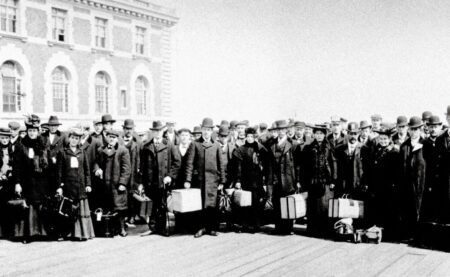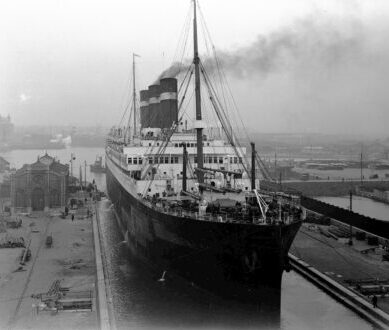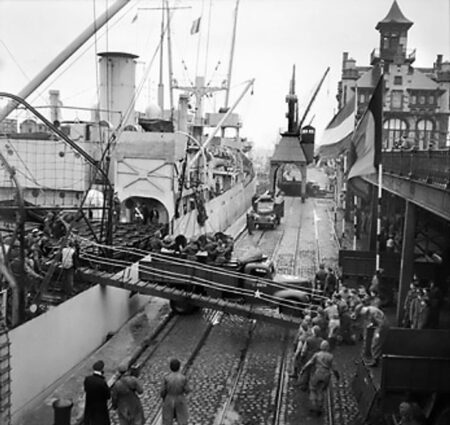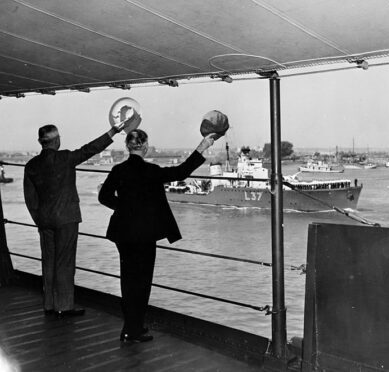Maturity
The intermittent 15-year period that Antwerp was part of the Dutch Kingdom was also a period when River Scheldt was open to both navigation and trade after a long period that had put the city’s economy into a state of a coma. The short period of resurrection ended with the Belgian revolution. Antwerpians had to wait until River Scheldt finally reopened for good in 1863 saving the city from the asphyxiation of the long-lasting trade restrictions.



Between 1863 and 1890 the available length of the city’s quays expands six-fold. In that same period, the volume of exports from the port of Antwerp also grows six-fold. New records for imports and transit freight were set by the day. The port of Antwerp became once more a European trading hub with leading international trading firms establishing their branches in a new peaceful environment. Exports were dominated by iron and steel products: exports of iron and steel quadrupled to 1.3 million tonnes. Also in this period, the Red Star Line starts operating. Eventually, the shipping company carries some two million emigrants from Antwerp to America.



After two long centuries, the thriving port of the city became once more the vessel that carried Antwerp to a new age of prosperity. The explosive growth of maritime activity in Antwerp’s port which in only a few years managed to surpass its Dutch counterparts was reflected in the rise of every economic index but was most evident in the impressive increase in the population.
From 73.500 people in 1830 to 173.600 in 1879. The old walls are demolished to make way for the city’s expansion, and several new docks and grand new buildings like the Flemish Theatre, the Hendrik Conscience Public Library, and the Museum Plantin-Moretus are constructed.



The city is booming again. A new international fair, the Exposition Internationale d’Anvers is inaugurated in May of 1894 attracting more than 3 million guests by the end of the same year. A few years later, in 1902 the electric tram would complete its first route carrying Antwerp in the new electric age. Three years later Antwerpen-Centraal railway station opens its gates for passengers.



Just before World War I the city’s population had been catapulted to more than 350.000 people. Although the Belgian government and King Albert I wanted to refrain from any warfare between the French and Germans and had announced that the Belgians would remain neutral, the country’s critical geographical position would bring the war to its doorstep.
On the morning of August 4, 1914, the German army invaded Belgium after the Belgian government refused to allow the passage of the German troops headed for France. After the two first battles in Liege on August 5 and at Halen on August 12, the Belgian army was ordered to retreat to Antwerp which was protected by a series of 95 km long defensive fortifications known as the National Redoubt built from 1859 to 1914 to make the city impenetrable.






On the night of 25 to 26 August, the city was bombed for the first time by a German Zeppelin airship. On 28 September the German artillery began a heavy bombardment of the city with more than 160 heavy guns and four super heavy 42cm howitzers that after 11 days of constant pounding managed to blow the city’s defenses into dust. The guns caused severe damage to many of Antwerp’s buildings and forced the Belgian army to retreat even further. The Germans would occupy Antwerp until the end of the war in 1918.


In 1920 Antwerp officially entered the post-war era with the first global event after the horrific days of the war, the 7th Summer Olympics, as the host city. With the wounds of the collision still open, the nations that lost the war Hungary, Germany, Austria, Bulgaria, and the Ottoman Empire were banned from competing. Many stadiums like the Palais de Glace d’Anvers and the Olympisch Stadion were built especially for the event while other venues such as the Antwerp Zoo and Nachtegalen Park were incorporated into the ensemble of the Olympic venues for various Olympic sports.



In 1923 the first Airport of Antwerp opened its first runway and a pilot’s school was established. Five years later following a centuries-long tradition the first diamond stock market worldwide, the Antwerpsche Diamantkring would make Antwerp the official diamond capital of the world.


The Jewish population, part of Antwerp’s life since the 13th century grew significantly in the first half of the 20th century reaching the number 50.000 on the eve of WWII. During the late 1930s, there were in Antwerp three distinct Jewish communities, five synagogues, and twenty-eight Jewish schools.



The Nazis invaded Belgium on the 10th of May 1940. On the 19th of May, two days after the fall of Brussels, Antwerp had fallen as well. Food rationing, rampant inflation, tight censorship of all printed material, prohibition of any opposing radio broadcasts and constantly increasing repression became a daily routine of Belgian citizens who hadn’t joined the pro-Nazi or collaborationist side.



Although the majority of the Jewish population of the city tried to flee to non-occupied countries, about 25.000 of them wouldn’t succeed. The fact that contrary to what happened in Eastern Europe, the German occupation forces did not start their anti-Jewish persecutions immediately, would lead many of them back to Antwerp. In October of 1940 however, that policy changed. More than 65% of the city’s Jews perished in the Holocaust, the synagogues were looted and burnt, and most Jewish-owned shops were destroyed.


The success of the allies on D-Day in June of 1944 and the quick advance of their forces toward Germany created a pressing need for a port that could serve the huge demand for supplies as close to the front line as possible. Antwerp’s port, with a capacity to handle more than 1000 ships at a time was a perfect candidate as Winston Churchill emphasized in his letters to his chiefs-of-staff from September 8th, 1944. On the 4th of September 1944, the British 11th Armored Division with the help of the Belgium Resistance managed to crush the German resistance and end the German occupation of Antwerp.


Taking the city of Antwerp alone wasn’t enough however to secure the supply line of the allies and the unobstructed passage of their ships. The Scheldt estuary was still under German control. In the so-called Battle of the Scheldt, the Canadian First Army managed to clear the estuary after five weeks of numerous amphibious assaults and difficult fighting. The success of the campaign to liberate Antwerp and its port came with a heavy cost in human lives, with the allies counting nearly 13.000 dead and wounded in battle.



After the devastating war, the wounded city entered a period of fervent reconstruction of all damaged buildings and infrastructure with the expansion and modernization of its port becoming the project with the highest priority, especially after 1955.
Modern-day Antwerp is an extrovert metropolis of more than half a million permanent residents and more than 1.200.000 in the wider metropolitan region, out of which more than 30%haves a migrant background. The largest group of foreign residents comes from Morocco while the Jewish community continues to have a strong presence, especially that of Haredi or Ultra-Orthodox Jews which is one of the largest in the world outside Israel.



Antwerp’s economy is still fueled to a great extent by the activity of its port, one of the largest (in tonnage) in the world. The diamond industry, tourism, and trade also play a vital role in the city’s growth and prosperity. With a modern railway system, an international airport, and modern multi-lane motorways connecting it to the rest of the country and Europe, Antwerp is, even more, today than it always was. A North-European hub of commerce; a leading vibrant metropolis of the Flemish region.






